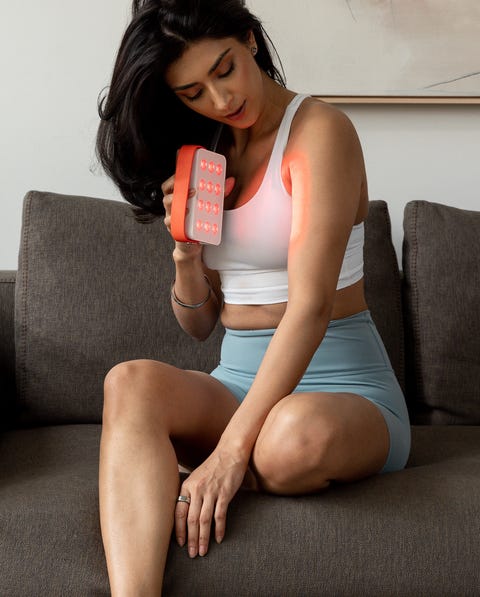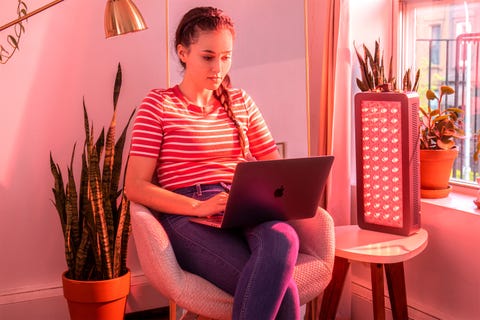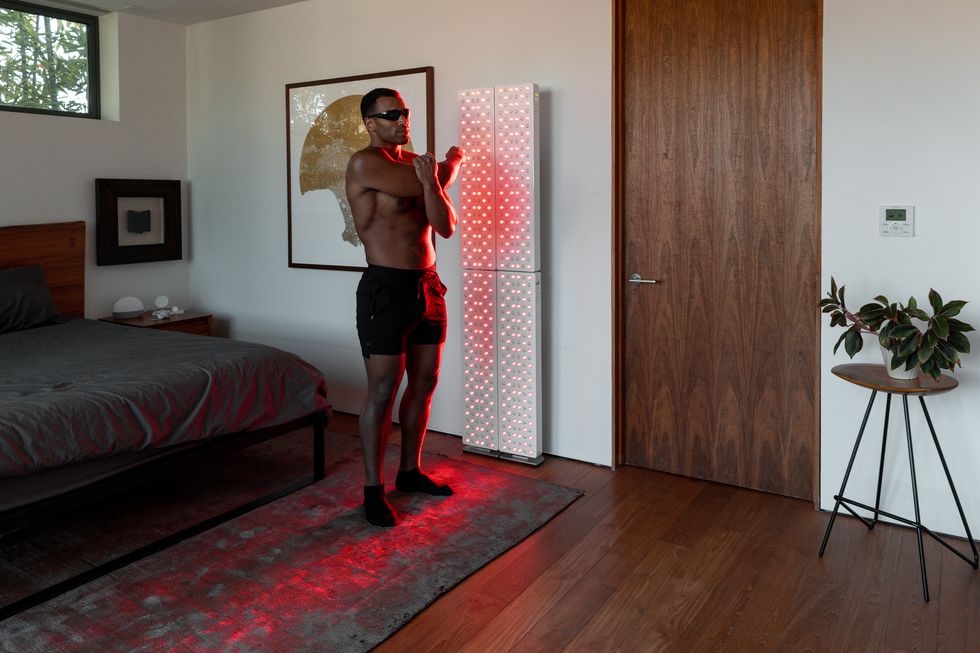Source: GearPatrol
Here’s how it works and why to try it.
What Is Red Light Therapy?
In its most basic form, red light therapy — RLT for short — is a treatment that uses red light at varying wavelengths to target cellular stimulation for the sake of better health. The energy from light-emitting diodes brings energy to these tired cells, causing them to enter a process of self-repair. As a result, exposure to red light during treatment can lead to a number of benefits, depending on how routine exposure becomes and how deep the wavelengths are able to penetrate the skin.

How Does Red Light Therapy Work?
Unlike other recovery methods like percussive massage or foam rolling, RLT works from a non-invasive nature meaning you don’t need to actively engage your muscles and cells to generate relief. All that’s needed is an at-home RLT device and some time spent in front of the light-emitting diodes. Treatment can range anywhere from 5–30 minutes, depending on the amount of pain felt post-workout.
In this time, the light enters your cells without any feeling or sensation, triggering a biochemical effect that supposedly strengthens the present mitochondria — the powerhouses of the cell. Think of your mitochondria as power plants for cellular energy, and what’s a stronger power plant to do but act more efficiently in terms of making the cell function properly? Thanks to the energy boost from RLT, your mitochondria are more equipped to kickstart the rejuvenation and repair process required post-workout.
RLT can carry with it a number of benefits, but the perks are determined by how deep the light can reach within your skin and musculature. In order to reach the desired depths, many RLT devices employ multiple light types, each with their own wavelength.

Regular Red Light
Regular red light is the visible red glow you see across devices, with a wavelength measuring between 630–660 nanometers. This wavelength can typically reach a shallower depth of around 2mm, making it ideal for topical medical issues. Ailments like hair growth, skin resurgence and other factors can greatly benefit from devices offering this light type as part of their spectrum.
Near-Infrared Light
Near-infrared falls in the range of 810–850 nanometers and is ideal for that deep muscle repair and reduced inflammation. Devices offering NIR light can penetrate as deep as 5mm, which is great for targeting the muscles, joints and bone stresses most athletes feel post-training.
Infrared Light
Infrared, the longest wavelength available in RLT, can measure over 900 nanometers for the deepest relief, which is best suited for chronic pain and joint stiffness. This light type is far more powerful than regular red light or NIR, and as such, is rarely offered in at-home modules. Additionally, that power can also create a heat sensation, which is why infrared lights are often used in larger saunas at treatment institutions.
What Are the Benefits of Red Light Therapy?
Now that you know the ins and outs of RLT, it’s time to decipher the potential benefits of the practice. Three main perks come with this recovery method. While there are other perceived positives to RLT, these three, in my opinion, are the most noteworthy.
Reduced Inflammation
When you work out, you develop micro-tears across your musculature, which leads to soreness through the increased blood flow and pressure across the area. This blood flow is a response from your body understanding that the healing process is ready to start. Rather than wait for the blood to do its job at a normal pace, red light can help speed up the process by increasing the energy stores of the present mitochondria, getting the self-repair started in a higher gear, so to speak.
Supercharged Cellular Energy
In addition to muscle repair and relief, all that cellular energy can help keep surface level systems more vibrant and active through red light therapy. The easiest area to notice this is at the skin, as RLT can be a great solution for defending against (and sometimes eliminating) wrinkles. RLT has also been shown to help reinvigorate hair growth, soothe and wash away scar tissue and other positive cosmetic factors.
Less Intense Recovery
Finally, red light therapy is perhaps the most hands-off recovery method you can employ outside of sleeping. You just need to carve out 5–30 minutes of your daily schedule, strap on some eye protection and sit. No kneading, no shocking. Just relax as the light does the post-training work for you.
About Passiva
Passiva is an innovative materials science company that provides a revolutionary biotech platform to cost-effectively bring device-free therapeutic red light capabilities as an added ingredient or component to everyday medical, cosmetic, or vision care products.

